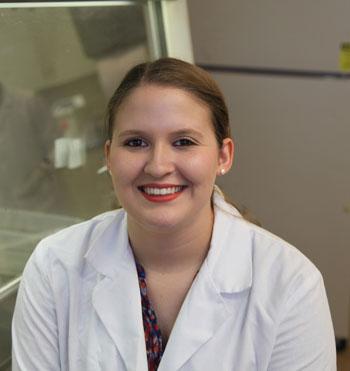
Research and Medicine
Friday, July 29, 2016
“I think the Summer Research Program is just a really great opportunity for anyone who is even considering research,” said Casey Landis, a rising second year veterinary student at OSU’s Center for Veterinary Health Sciences from Skiatook, Okla. “There needs to be more veterinarians in research. Research is a big part of medicine. If we didn’t have research, we wouldn’t have medicine (human or veterinary). As a practicing veterinarian, you need to know all the information you can. If you know about performing research, you will know more about the research techniques used to study animals and pharmaceuticals, treatments and all of that. This is a great program to get people interested and see if this is something they want to do for the rest of their life.”
Landis grew up on a cattle ranch and since age five has wanted to become a veterinarian. She is leaning toward going into a mixed animal practice and eventually owning her own clinic. However, she hasn’t ruled out a career in research and is spending her summer in OSU’s Summer Research Scholars Program working in Dr. Jerry Malayer’s laboratory. Malayer is a professor and the associate dean for research at the veterinary center.
“My research project is developing a co-culture model of macrophages and hepatocytes, which I will infect with Francisella tularensis and then visualize the infection with flow cytometry, confocal microscopy and PCR,” said Landis.
“Francisella tularensis is a bacteria that can affect animals and people,” she continued. “When it infects somebody, it mostly targets the liver. The liver is made up of hepatocytes, or liver cells, and macrophages, which are found pretty much everywhere in the body. We are creating a model of a liver and infecting it and then observing the infection through these three methods to see the course of infection through the cells and how it avoids destruction by the body so that it can keep replicating and making people sick. This is a pretty harmful bacteria, so it’s important to study.”
“Casey had some previous laboratory experience,” explained Malayer. “She worked here with Dr. Fulton in the college and did a really good job. The fact that she enjoyed that experience enough to come back and want to do more was a very good sign. She’s done a remarkable job. She is very good at thinking through things for herself. She’s self-reliant. She’s looked up papers from the literature, answered questions for herself, come up with suggestions and solutions to problems, which is really what we look for in somebody that has research interests.
“She is developing a cell culture system that involves multiple cell types that will allow us to study the infection, the biochemistry if you will, of the interactions among these cells, and how they respond to one another in a culture system. The organism she is working with will infect liver cells and macrophages, which are part of the immune system. We will study the interrelationship/interaction between those cell types,” he added.
“I’ve learned a lot of things so far,” said Landis. “I have learned how to do a cell culture because I have to culture my macrophages and hepatocytes so that I can infect them. I’ve also had to start growing my bacteria so I learned how to do all of that. And then I am working on an infection assay to work on finding the correct amount of bacteria to infect my co-culture model with. Hopefully I will start flow cytometry followed by confocal and PCR.
“I’m also working on a co-culture of human cells and mouse cells,” she continued. “Most of the studies on this bacteria are in mice previously so I’m going to try to look at human cells and compare them with the mouse cells to see if there is any difference. I think this is really exciting because it’s a very important disease. It affects not only animals but people, which makes it important to study and really understand.”
“The Summer Research Scholars Program has been around for many years,” added Malayer. “In 2007, a National Academy of Sciences report emphasized the need for more veterinarians to go into biomedical research. Veterinarians bring a very interesting and unique perspective because of the comparative medicine training they receive. They ask different kinds of research questions that can be extremely valuable.
“We really make an effort to be sure that we are doing our part to contribute to the numbers of veterinarians that were trained and had opportunities to do research,” he concluded. “This program gives students a research experience to see if they like it and if it is something they can incorporate into their career paths. We have had pretty good luck with that over the years. We have now graduated about a dozen DVM/PhDs. People have ended up on faculty at other places doing a great job. We have several more in the pipeline and we’re hoping to add more in the future.”
For more information on research opportunities at Oklahoma State University’s Center for Veterinary Health Sciences, visit our Research page.
